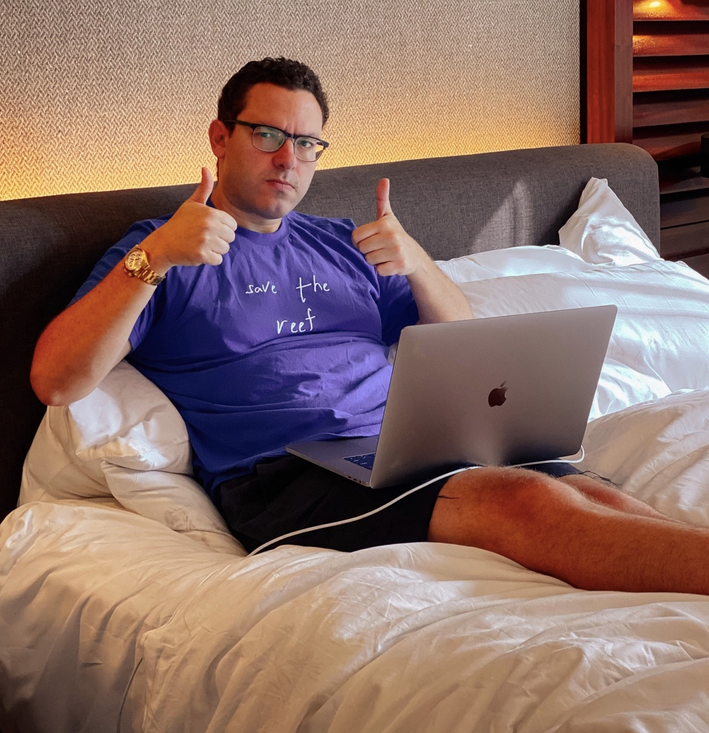It seems more and more traders are interested in algorithmic trading. But is it really possible to profit from it?
People think you have to be some math wiz or genius to trade stocks. I don’t think so. I’m not that smart — if I can do it, I think you can too.
But algo trading is a whole other beast. If you want to use it to your advantage, you’re going to need some computer programming and coding knowledge.
Needless to say, this style of trading isn’t for newbies. But you can learn what you’re up against in the market and find out why I stick to my penny stock niche.
In this post, I’ll go over what an algorithm is, some algorithmic trading strategies, software, and examples. Read on…
Table of Contents
- 1 What’s Algorithmic Trading?
- 2 Algorithmic Trading vs. Other Technical Trading Techniques
- 3 Why Should I Use Algo Trading?
- 4 Benefits of Algorithmic Trading
- 5 Disadvantages of Algorithmic Trading
- 6 How Do I Start Algorithmic Trading?
- 7 How Is Coronavirus Impacting Algorithmic Trading?
- 8 Frequently Asked Questions About Algorithmic Trading
- 9 Conclusion: Is Algorithmic Trading Worth It?
What’s Algorithmic Trading?
This is trading that’s executed by a computer system. It’s a system that’s built to trade based on specific instructions.
The instructions for an entry or exit may be based on technical indicators, price, volume, or any other parameters of a possible trade, as long as it can be entered into a computer as code.
Algo trading is mostly used by institutional investors, hedge funds, and mutual funds. But algorithmic trading software has made it easier for retail investors to take advantage of the technology.
Algorithmic Trading vs. Other Technical Trading Techniques

Algorithmic trading is a hands-off trading method. Once a trader enters code into the computer and it’s set to trade live, all that’s left for the trader to do is monitor the positions.
Other technical trading techniques involve studying chart patterns, watching for reactions at key levels, and then deciding whether to take the trade. You’ll have to manually enter the trade into your order box with the price and number of shares you want.
If your trading strategy is to buy breakouts and you’ve entered your trading plan into a computer code, you’re done. The computer won’t think about whether to take the trade or how many shares to buy or at what price. And there’s no time wasted thinking if it’s a good trade to take.
Once the trade triggers the code, the computer executes the trade. No questions, no hesitation, no emotion.
Why Should I Use Algo Trading?
Algorithmic trading is executed much faster than a human can enter an order for a trade. It also cuts out any human emotion around the trade.
There’s less delay in order execution and less chance for human error.
It could also be an option if you have a 9-to-5 job and can’t watch charts and trades all day. The computer can execute trades for you, and you just check in each evening to monitor positions and make adjustments if needed.
But it’s not for everyone. It’s a complex strategy to get into. You need programming and coding knowledge, as well as trading knowledge, to have a profitable strategy for the algo to trade for you.
I prefer to stick to my simple penny stock niche. You don’t have to be a math wiz to trade penny stocks. I trade simple predictable patterns, I stick to my rules, and I trade safely.
Benefits of Algorithmic Trading
Let’s look at some of the benefits of algo trading…
Perfection
OK, perfection is a strong word. But trades executed by computers don’t have the problems most people have when it comes to trading.
There’s no emotion, no hesitation, and no second-guessing. The computer does what it’s told to do. No matter what.
That doesn’t mean every trade the computer takes will be a winner. But it’s going to take the trade if the indicators line up. And it’s going to sell when the trade hits the sell triggers.
It’s not going to get greedy and hold for more profits, and it’s not going to hold and hope a loser turns into a winner.
Hands Off
Having an algorithm trade for you potentially can cut out a lot of the time-consuming work of trading. You won’t have to dedicate as much time each day to scan the market for potential trades.
Or plan for trades that may or may not happen, set risk levels, or watch the market all day for a pattern to set up.
You won’t have to contemplate whether to take a trade or to skip it.
You can just check your positions each day to make sure everything is working correctly. And you can make adjustments to your programming if you need to.
Because the markets are always changing, you have to adapt, and so does your algo.
Disadvantages of Algorithmic Trading

The advantages of algo trading sound pretty good. But there are disadvantages too…
More Breaking News
- JetBlue Airways Expands Horizons: Is It Set To Soar Or Stall?
- What’s Driving Canaan Inc.’s Stock Surge? Unpacking Recent Market Movements
- CleanSpark Inc.: Unraveling the Stock’s Recent Plunge
It’s Expensive
If you can’t program a computer or enter code yourself, you could be looking at high costs to pay someone to do it for you.
You can’t just set up an algo and leave it forever. You’ll have to be constantly tweaking it to adapt to market changes. If you have to pay someone to do that each time, the costs can add up.
And if you’re a new trader without your own strategy, you’ll have to pay someone to use theirs. If a strategy has the potential to give you profits over and over, it won’t be cheap to get.
It’s Not for New Traders
Setting up and trading with an algorithm is quite complex. You can’t just jump in and start algo trading.
First, you need to have some good trading knowledge behind you before you even consider having a computer execute trades for you.
You also need computer programming and coding knowledge. Once you have all the knowledge, it takes a lot of time to program the algo and run all your backtesting and paper trading before trying it live.
The complexity of algo trading and competing against hedge funds and institutional investors is why I trade penny stocks. And it’s why I teach students to trade them. I think they’re great for someone starting out with a small account. They offer easy-to-learn patterns that repeat over time.
You don’t need to be a computer programmer or know anything about writing code. You can start with a few thousand dollars and a good teacher.
If you want a great resource to get started on your penny stock trading education, join my 30-Day Bootcamp. It’s a month’s worth of lessons with daily assignments and homework. And you can work at your own pace and repeat it as many times as you like. Bonus: It comes with “The Complete Penny Stock Course” book and my “Pennystocking Framework” DVD.
Be ready to study and do the work! If you’re ready to take your education to the next level, apply for my Trading Challenge.
How Do I Start Algorithmic Trading?

Before you can start algorithmic trading, you need a strategy that has specific parameters that can be entered into a computer program as a code.
You’ll want to backtest that strategy before trading it live in the market. Backtesting is a way to test out a strategy based on past market moves. Find out how to backtest a trading strategy here.
After you backtest it, you can paper trade your strategy on StocksToTrade to test it on current market conditions before trading it live.
(Full disclosure: I helped develop StocksToTrade and I’m a major investor. That said, it’s my dream stock-scanning tool. It’s designed to help save time in finding the best stocks that fit my patterns and strategy.)
Once you have a trading strategy that works in the market, you’ll need algorithmic trading software. You can do algorithmic trading with Python if you can write your own lines of code.
You can hire a computer programmer to enter your code or develop a program for you.
Algorithmic trading strategies must be based on actionable signals that can be input into your trading software. There’s no such thing as an algorithm based on hunches or feelings…
Three Top Algorithmic Trading Strategies
Trend Following
Trend following is a type of trading in which you try to take advantage of trends. It’s the most popular and simplest way to algo trade. That’s because it has technical indicators for entries and exits that are relatively easy to program as code.
This is a popular trading strategy when you’re looking for entries off a dip at a support level or moving average, or when a stock breaks out of consolidation or makes new highs.
You can set your exit similar to a trailing stop — if the stock drops a certain percentage or dollar amount you feel would signal the end of the trend. Or you set a sell at a certain dollar or percent profit. That can be risky, though. If the stock doesn’t meet the goals, have another stop loss in place.
Algo trading is usually used by high-frequency traders, and buys and sells are executed quickly. But you can set the algo to trade on any timeframe. For swing trades, you want to enter on signals on the daily chart and hold for a few days or weeks.
Range Trading
Range trading is another simple algo trading setup. It’s based on the probability that a stock that trades in a range will continue to do so. And if it breaks out of that range, it will probably return to its average price point.
You can program your algo to buy dips and sell at the average price, or short sell spikes and buy to cover when it returns to the average range.
Arbitrage Trading
Arbitrage trading is a little more complex. It’s based on trading a stock that trades in two different markets.
It works by setting the computer to buy the stock on one market and automatically sell it on the other and profit from the difference. This type of trade takes advantage of market inefficiencies.
I love to take advantage of inefficiencies in penny stocks in my trading. Other traders’ lack of knowledge and education creates opportunities for me and my students.
I finished today +$1,697 trading overly-safe on $BANT $SFOR $TTNP $ASTC but being extra-careful not to avoid the same fate as those who hold & hope on $DIA $SPY $QQQ $SPAQ $CBB $INNO $GNUS $REKR $KERN $RKT who need to learn to respect price action instead of believing promoters!
— Timothy Sykes (@timothysykes) October 28, 2020
Technical Requirements for Algorithmic Trading
To be able to set up a trading algorithm, you’ll need access to a few tools…
Knowledge is the first tool you need for any kind of trading. For algorithmic trading, you need knowledge of a trading strategy, and you need the computer knowledge to be able to program software to your strategy.
Otherwise, you’ll need to hire a computer programmer to write your code.
You’ll need access to the markets through your brokerage account. And you’ll need connectivity through your trading program and your brokerage.
You’ll also need access to historical data to do your backtesting. You can use a service like Quantconnect, which has a free backtesting tool and financial data.
What’s the Best Algorithmic Trading Software?
There are a few options for algorithmic trading software. There’s no one ‘best’ software. Like everything in trading, it’ll come down to which one you personally prefer.
Here’s a short list of software available. There are more options out there if you do some research.
- Quantopian
- Quantconnect
- Amibroker
- Metatrader
Try them out and see which one you like best.
Example of Algorithmic Trading
Before you can build an algorithmic trading program, you need to have a plan, just as if you were trading the setup yourself. You need to know your goals for the trade, your risk levels, and what signals entry and exit for the trade, either with profits or a small loss.
Let’s say you want to set up your algo to buy breakouts. You would put in a line of code that indicates to buy on new 52-week highs. You would program a stop-loss below your entry in case the breakout doesn’t work.
You’d place another stop-loss as a trailing stop to follow your trade upward. Then, you enter instructions to sell your position if the stock has a downward move of 50 cents, or whatever your risk level is for the trade.
It all depends on your timeframe for the trade, your position size, and the volatility of the stocks you trade.
You could just program a sell order at your profit goals, but with a trailing stop-loss in case the stock doesn’t make it to your target price before reversing.
There seems to be a belief on Wall Street that algo trading adds volatility to the market. Algos chase the money. Once a trend starts, the algos keep buying until it changes.
Once it changes, they all react at the same time and initiate sell orders. This can cause big sell-offs in a short time.
The coronavirus caused a big sell-off that was made worse by algo trading as sell orders were triggered. The subsequent recovery is also partly attributed to algo trading following the trend.
The sell-off also brought a lot of new traders and investors into the market, leading to huge volume increases and exacerbating daily volatility. (If you haven’t already gotten my “Volatility Survival Guide,” get it for no cost here.)
These new market participants have added to the volatility in the market by buying stocks when they were at discount prices. Now we’re seeing a cycle of buying driven by new traders and algos chasing opportunities.
Frequently Asked Questions About Algorithmic Trading
Can You Make Money With Algorithmic Trading?
Yes, you can make money with algorithmic trading. But it takes a lot of market knowledge and computer knowledge to implement a system that can generate returns. That’s why I prefer to trade penny stocks using the rules I’ve learned in over 20 years of trading.
What Percentage of the Market Is Algorithmic Trading?
The market is approximately 80% algorithmic or automated trading. There’s also algorithmic trading in the forex, options, and futures markets, but to a lesser degree. It’s another reason I stick to volatile penny stocks. There’s less competition from big traders.
Does Algorithmic Trading Worsen Stock Market Volatility?
Some believe that algo trading increases stock market volatility. That’s because algorithms are generally programmed to trade on the same signals, which creates a rush of buying or selling activity when triggers are hit.
Is Algorithmic Trading Illegal?
No algorithmic trading isn’t illegal. It makes up most of the trading in the market. It’s used by institutional investors, hedge funds, and mutual funds.
Conclusion: Is Algorithmic Trading Worth It?

I personally don’t use algorithms to trade — and I probably never will. Heck, I don’t even trust having a stop-loss order sitting in the system before I’m ready to actually sell.
But just because it’s not for me doesn’t mean it might not work for you. If you have computer programming skills or know a bit about coding, you might find success with it. And even if it’s not for you, it’s smart to know what’s going on in the overall market.
I’ve been trading in the markets for over 20 years. I’ve made enough mistakes to know what works for me and what doesn’t. And I think my strategy is a good place to start for new traders. You can start with a small account and work to grow it over time.
I stick to simple penny stock patterns. And that’s what I teach my students in my Trading Challenge. I have six millionaire students so far.* And I want more! If you’re dedicated to your trading education, apply today.
Have you tried algorithmic trading? Let me know in the comments … I love to hear from you!
(*These results are not typical. Individual results will vary. Most traders lose money. My top students and I have the benefit of many years of hard work and dedication. Trading is inherently risky. Always do your due diligence and never risk more than you can afford to lose.)







Leave a reply